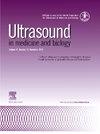血管标记超分辨率超声肝门静脉灌注成像。
IF 2.4
3区 医学
Q2 ACOUSTICS
引用次数: 0
摘要
目的:肝门静脉血流显像及血流灌注评价对肝硬化、原发性及转移性肝肿瘤等多种肝脏疾病的诊断具有重要意义。然而,由于肝脏独特的双血供系统,门静脉的灌注成像具有挑战性。方法:我们开发了一种门静脉和下游血管特异性灌注成像的新方法,并在健康小鼠(n = 4)上进行了验证。使用超快平方波多普勒成像和血管标记对健康小鼠肝脏右叶进行了顺序成像。在每个实验中,小鼠首先注射相变纳米液滴(PCNDs),然后立即进行超快多普勒成像以确定成像切片并定位门静脉分支。通过交互过程,通过鼠标点击选择门静脉分支,进行基于PCNDs的血管标记超声(VLUS)数据采集。随后的到达时间计算和超分辨率超声(SRUS)成像离线进行。为了证明所提出的血管成像方法的特异性,我们给一只小鼠注射了Sonovue微泡,用于平面波超声数据采集和基于微泡的VLUS数据采集。所有成像实验均在Verasonics (Kirkland, WA, USA) Vantage 256超声系统上进行,采用1222 -8v线性阵列换能器,中心频率为15.625 MHz。多角度相干复合平面波采集帧率为500 Hz。结果:健康小鼠(n = 4)的成像结果表明,VLUS能够标记肝门静脉的不同分支,并特异性成像下游血管。不同空间尺度的体内结果分析显示,标记开始后下游灌注区亮度明显增强,而标记开始前与结束后图像亮度无显著差异。通过对焦点处声场分布的分析,声场在x1和z1方向的半最大全宽度分别为98.56 μm和526.68 μm。沿着聚焦光束的传播路径(标记区域外),未观察到PCNDs的显著激活(p < 0.0001)。结合SRUS技术,进一步提高了VLUS门静脉成像结果的分辨率。下游感兴趣区域的时间强度曲线表明,VLUS为下游血管提供了阶跃输入信号。根据时间-强度曲线中阶跃点到达时间,可以计算出下游船只相对于标记点到达时间分布图。结论:提出了一种基于VLUS的肝门静脉灌注成像新方法。体内实验、仿真结果和统计分析表明,该方法能够以毫米级精度准确标记门静脉血管,实现特异的高分辨率成像和下游灌注区精确、无创测量。将VLUS与SRUS技术相结合,可以进一步提高门静脉成像结果的分辨率。本文章由计算机程序翻译,如有差异,请以英文原文为准。
Hepatic Portal Venous Perfusion Imaging Using Vessel-Labeling Super-Resolution Ultrasound
Objective
Blood flow imaging and perfusion assessment of the hepatic portal vein are critical for the diagnosis of several liver diseases, including cirrhosis, primary and metastatic liver tumors. However, perfusion imaging of the portal vein is challenging due to the unique dual blood supply system of the liver.
Methods
We developed a novel method for specific perfusion imaging of the portal vein and downstream vessels, which was validated on healthy mice (n = 4). The right lobe of the liver in healthy mice was sequentially imaged using ultrafast plane-wave Doppler imaging and vascular labeling. In each experiment, mice were first injected with phase-change nanodroplets (PCNDs), followed immediately by ultrafast Doppler imaging to determine the imaging section and locate portal vein branches. Through an interactive process, portal vein branches were selected by mouse click for data acquisition of vessel-labeling ultrasound (VLUS) based on PCNDs. Subsequent arrival time calculations and super-resolution ultrasound (SRUS) imaging were performed offline. To demonstrate the specificity of the proposed method for vascular imaging, one mouse was injected with Sonovue microbubbles for plane-wave ultrasound data acquisition and microbubble-based VLUS data acquisition. All imaging experiments were conducted on the Verasonics (Kirkland, WA, USA) Vantage 256 ultrasound system using an L22-8v linear array transducer with a center frequency of 15.625 MHz. The multi-angle coherent compounding plane-wave acquisition frame rate was 500 Hz.
Results
Imaging results from healthy mice (n = 4) demonstrated that VLUS was able to label different branches of the hepatic portal vein and specifically image downstream vessels. Analysis of the in vivo results at different spatial scales showed that the brightness of the downstream perfusion area was significantly enhanced after labeling started, while there was no significant difference in image brightness before the labeling started and after it ended. By analyzing the acoustic field distribution at the focal point, the full width at half maximum in the x1 and z1 directions were 98.56 μm and 526.68 μm, respectively. Along the propagation path of the focused beam (outside the labeling area), no significant activation of the PCNDs was observed (p < 0.0001). Combined with SRUS technology, the resolution of the VLUS portal vein imaging results was further enhanced. The time-intensity curves of the downstream regions of interest indicated that VLUS provided a step input signal to the downstream vessels. Based on the arrival time of the step point in the time-intensity curves, the arrival time distribution map of the downstream vessels relative to the labeling point could be calculated.
Conclusion
We propose a novel method for hepatic portal vein perfusion imaging based on VLUS. In vivo experiments, simulation results and statistical analysis demonstrate that this method is able to accurately label portal vein vessels with millimeter-level precision, enabling specific high-resolution imaging and precise, non-invasive measurement of the downstream perfusion area. By combining VLUS with SRUS technology, the resolution of the portal vein imaging results can be further enhanced.
求助全文
通过发布文献求助,成功后即可免费获取论文全文。
去求助
来源期刊
CiteScore
6.20
自引率
6.90%
发文量
325
审稿时长
70 days
期刊介绍:
Ultrasound in Medicine and Biology is the official journal of the World Federation for Ultrasound in Medicine and Biology. The journal publishes original contributions that demonstrate a novel application of an existing ultrasound technology in clinical diagnostic, interventional and therapeutic applications, new and improved clinical techniques, the physics, engineering and technology of ultrasound in medicine and biology, and the interactions between ultrasound and biological systems, including bioeffects. Papers that simply utilize standard diagnostic ultrasound as a measuring tool will be considered out of scope. Extended critical reviews of subjects of contemporary interest in the field are also published, in addition to occasional editorial articles, clinical and technical notes, book reviews, letters to the editor and a calendar of forthcoming meetings. It is the aim of the journal fully to meet the information and publication requirements of the clinicians, scientists, engineers and other professionals who constitute the biomedical ultrasonic community.

 求助内容:
求助内容: 应助结果提醒方式:
应助结果提醒方式:


